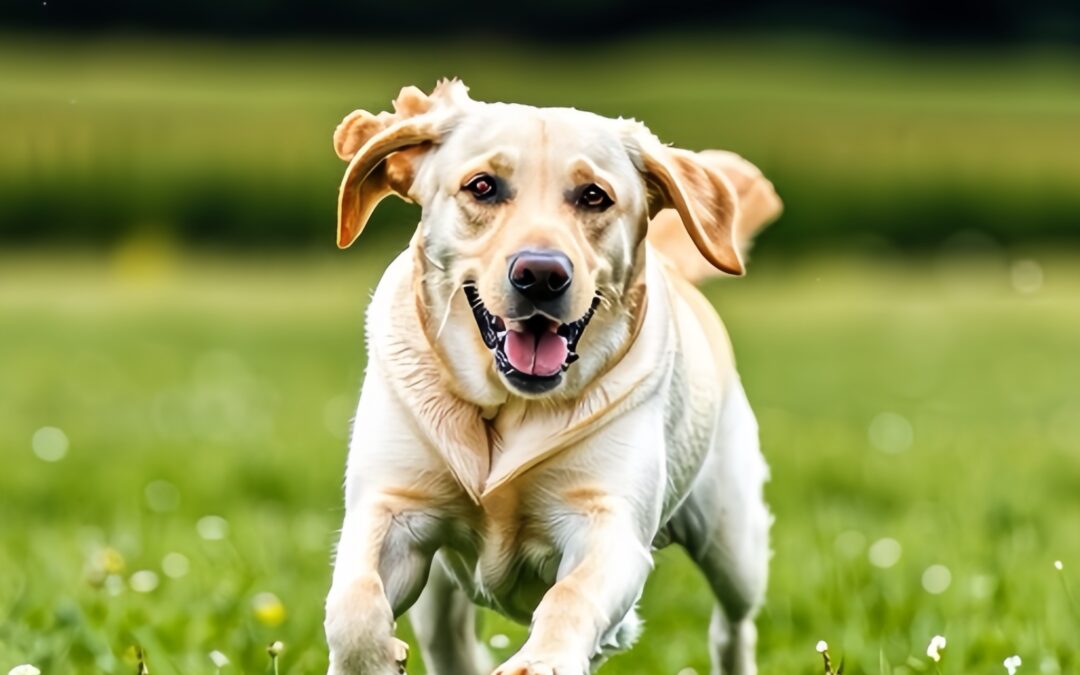
utworzone przez TCMVET | cze 27, 2024 | Rak i guzy u psów
Kiedy u psa zostaje zdiagnozowany nowotwór, priorytetem staje się utrzymanie jakości jego życia. Jednym z ważnych aspektów opieki, który często pojawia się pod znakiem zapytania, jest to, czy psy chore na raka powinny kontynuować codzienne spacery. Odpowiedź brzmi zdecydowanie tak, należy jednak pamiętać o kilku ważnych kwestiach. Oto dlaczego codzienne spacery mogą być korzystne dla psów chorych na raka i jak najlepiej je wykorzystać.
Korzyści z codziennych spacerów dla psów chorych na raka
- Utrzymanie zdrowia fizycznego: Regularne spacery pomagają psom utrzymać masę mięśniową, która ma kluczowe znaczenie dla ogólnego stanu zdrowia i mobilności. W przypadku psów poddawanych leczeniu raka zachowanie siły mięśni może pomóc w powrocie do zdrowia i poprawić ich zdolność do radzenia sobie z leczeniem.
- Psychiczne samopoczucie: Spacery zapewniają stymulację umysłową i przerwę od środowiska wewnętrznego. Nowe widoki, dźwięki i zapachy napotkane na spacerze mogą poprawić nastrój psa i pomóc zmniejszyć stres i niepokój.
- Poprawiona cyrkulacja: Delikatne ćwiczenia poprawiają krążenie krwi, które jest niezbędne do dostarczania składników odżywczych i tlenu do tkanek. Może to wspomóc leczenie i ogólny stan zdrowia.
- Wzmocniona funkcja odpornościowa: Umiarkowane ćwiczenia mogą wzmocnić układ odpornościowy, pomagając psom lepiej zwalczać infekcje i radzić sobie z rakiem.
Czynniki, które należy wziąć pod uwagę w przypadku spacerów z psami chorymi na raka
- Poziomy energii: Ściśle monitoruj poziom energii psa. Rak i jego leczenie mogą powodować zmęczenie, dlatego dostosuj długość i intensywność spacerów w zależności od tego, jak Twój pies czuje się każdego dnia.
- Zarządzanie bólem: Upewnij się, że pies nie odczuwa bólu podczas chodzenia. Skonsultuj się ze swoim lekarzem weterynarii, aby skutecznie złagodzić ból, stosując w razie potrzeby leki lub inne terapie.
- Warunki pogodowe: Uważaj na pogodę. Ekstremalne temperatury mogą być trudne dla psa poddawanego leczeniu raka. Latem wybieraj chłodniejsze pory dnia na spacery, a zimą upewnij się, że Twojemu psu jest wystarczająco ciepło.
- Teren: Wybierz płaski, łatwy teren, aby zminimalizować obciążenie stawów i mięśni psa. Unikaj stromych wzniesień i nierównych ścieżek, które mogą powodować dyskomfort.
- Nawodnienie: Dbaj o nawodnienie psa, zwłaszcza podczas dłuższych spacerów. Noś ze sobą wodę i często podawaj ją swojemu psu.
Wskazówki dotyczące bezpiecznych i przyjemnych spacerów
- Krótkie, częste spacery: Zamiast jednego długiego spaceru rozważ kilka krótszych spacerów w ciągu dnia. Może to pomóc w zarządzaniu poziomem energii i zapobieganiu zmęczeniu.
- Wygodny sprzęt: Używaj szelek zamiast obroży, aby uniknąć ucisku na szyję psa. Upewnij się, że szelki są dobrze dopasowane i wygodne.
- Monitoruj swojego psa: Zwróć uwagę na zachowanie swojego psa. Oznaki zmęczenia, nadmiernego dyszenia lub niechęci do kontynuowania mogą wskazywać, że czas wrócić do domu.
- Pozytywne wzmocnienie: Używaj smakołyków i pochwał, aby zachęcić psa i sprawić, by spacery były pozytywnym doświadczeniem. Może to pomóc zmotywować ich nawet w dni, w których mogą nie czuć się najlepiej.
- Postępuj zgodnie z zaleceniami weterynaryjnymi: Zawsze konsultuj się ze swoim lekarzem weterynarii w sprawie najlepszego programu ćwiczeń dostosowanego do konkretnego stanu Twojego psa. Mogą oni udzielić porad dostosowanych do indywidualnych potrzeb, w zależności od stanu zdrowia Twojego psa.
Codzienne spacery mogą być korzystną częścią rutynowej opieki nad psami chorymi na raka, zapewniając korzyści fizyczne, psychiczne i emocjonalne. Dostosowując harmonogram spacerów do potrzeb psa i postępując zgodnie ze wskazówkami weterynaryjnymi, możesz pomóc utrzymać jakość jego życia podczas walki z chorobą nowotworową.
Regularne, delikatne ćwiczenia mogą poprawić nastrój, wesprzeć układ odpornościowy i pomóc lepiej radzić sobie z leczeniem. Uważne nadanie priorytetu codziennym wycieczkom może znacząco wpłynąć na dobrostan Twojego psa.

utworzone przez TCMVET | cze 27, 2024 | Rak i guzy u psów
Kiedy u Twojego ukochanego psa zdiagnozowano nowotwór, naturalną rzeczą jest chęć zrobienia wszystkiego, co możliwe, aby zapewnić mu komfort i zdrowie. Często pojawiającym się pytaniem jest, czy środowisko ich życia wymaga specjalnej dezynfekcji. Chociaż utrzymanie czystej przestrzeni życiowej ma kluczowe znaczenie dla wszystkich zwierząt domowych, psy chore na raka mogą skorzystać z dodatkowych środków. Oto, co musisz wiedzieć.
Zrozumienie znaczenia czystego środowiska
Czyste środowisko jest niezbędne dla ogólnego zdrowia i dobrego samopoczucia Twojego psa. W przypadku psów chorych na raka ich układ odpornościowy jest często osłabiony, co czyni je bardziej podatnymi na infekcje. Utrzymanie higienicznej przestrzeni życiowej może pomóc zminimalizować ryzyko wtórnych infekcji, które mogą skomplikować proces leczenia i powrotu do zdrowia.
Dlaczego konieczna może być specjalna dezynfekcja
- Osłabiony układ odpornościowy: Rak i jego metody leczenia, takie jak chemioterapia i radioterapia, mogą osłabić układ odpornościowy psa. To czyni je bardziej podatnymi na infekcje bakteryjne, wirusowe i grzybicze.
- Otwarte rany i miejsca operacji: Jeśli Twój pies przeszedł operację lub ma otwarte rany, obszary te są podatne na infekcję. Czyste środowisko pomaga w szybszym gojeniu i zmniejsza ryzyko infekcji.
- Skutki uboczne chemioterapii: Niektóre leki stosowane w chemioterapii mogą powodować działania niepożądane, takie jak wymioty i biegunka, które mogą zanieczyścić przestrzeń życiową. Regularne czyszczenie pomaga w utrzymaniu higieny i komfortu Twojego psa.
Wskazówki dotyczące utrzymania czystego środowiska
- Regularne czyszczenie: Regularnie czyść posłanie psa, zabawki oraz miski na karmę i wodę. Używaj łagodnych, bezpiecznych dla zwierząt środków dezynfekcyjnych, aby uniknąć narażenia psa na działanie agresywnych środków chemicznych.
- Dezynfekuj obszary wspólne: Skoncentruj się na obszarach, w których Twój pies spędza najwięcej czasu. Podłogi, dywany i meble należy często odkurzać i czyścić, aby usunąć kurz, włosy i potencjalne alergeny.
- Kontroluj wilgotność: Wysoki poziom wilgotności może sprzyjać rozwojowi pleśni i pleśni, które mogą być szkodliwe dla zdrowia Twojego psa. W razie potrzeby użyj osuszaczy, aby utrzymać komfortowy i bezpieczny poziom wilgotności.
- Jakość powietrza: Zapewnij dobrą wentylację w swoim domu. Używaj oczyszczaczy powietrza, aby zredukować patogeny i alergeny unoszące się w powietrzu.
- Higiena dłoni: Przestrzegaj zasad higieny rąk. Myj ręce przed i po kontakcie z psem, zwłaszcza jeśli podajesz leki lub oczyszczasz rany.
Rozwiązania w zakresie dezynfekcji bezpieczne dla zwierząt
Wybierając środki dezynfekcyjne, ważne jest, aby wybierać produkty bezpieczne dla zwierząt. Oto kilka opcji:
- Roztwór octu i wody: Naturalny i skuteczny środek czyszczący, który można stosować na różnych powierzchniach.
- Nadtlenek wodoru: Przydatny do dezynfekcji nieporowatych powierzchni i bezpieczny dla zwierząt.
- Komercyjne środki dezynfekcyjne bezpieczne dla zwierząt: Istnieje kilka produktów zaprojektowanych specjalnie dla zwierząt domowych, które są skuteczne i bezpieczne.
Równowaga pomiędzy czystością i komfortem
Utrzymanie czystego środowiska jest niezwykle ważne, ale równie ważne jest, aby proces czyszczenia nie stresował psa. Unikaj używania silnie pachnących środków chemicznych lub hałaśliwego czyszczenia, które mogłoby przeszkadzać Twojemu zwierzakowi. Dąż do równowagi, która pozwala utrzymać czystość bez uszczerbku dla komfortu i spokoju Twojego psa.
Zapewnienie czystego środowiska życia psu choremu na nowotwór wymaga regularnego czyszczenia i stosowania środków dezynfekcyjnych bezpiecznych dla zwierząt. Biorąc pod uwagę upośledzony układ odpornościowy, zwrócenie szczególnej uwagi na higienę może pomóc w zapobieganiu infekcjom i wspieraniu ogólnego stanu zdrowia. Wykonując te kroki, możesz stworzyć bezpieczną i wygodną przestrzeń dla swojego futrzanego przyjaciela podczas leczenia i rekonwalescencji.

utworzone przez TCMVET | cze 27, 2024 | Rak i guzy u psów
Przewlekły stan zapalny to utrzymujący się i często niezauważany problem zdrowotny, który może mieć poważne konsekwencje dla naszych psich towarzyszy. Ostatnie badania podkreśliły potencjalny związek między przewlekłym stanem zapalnym a rozwojem raka u psów. Zrozumienie tego powiązania ma kluczowe znaczenie dla właścicieli zwierząt domowych, którzy chcą podjąć aktywne kroki, aby zapewnić swoim psom długie i zdrowe życie.
Co to jest przewlekłe zapalenie?
Zapalenie jest naturalną reakcją organizmu na uraz lub infekcję. Jest istotną częścią procesu gojenia, ponieważ pomaga izolować i usuwać szkodliwe bodźce oraz rozpoczyna proces gojenia. Jednakże, gdy stan zapalny staje się przewlekły, może wyrządzić więcej szkody niż pożytku. Przewlekły stan zapalny charakteryzuje się przedłużoną reakcją zapalną, która może trwać miesiące lub nawet lata. Ten ciągły stan czujności może prowadzić do uszkodzenia tkanek i przyczyniać się do rozwoju różnych chorób, w tym raka.
Jak przewlekłe zapalenie prowadzi do raka
Związek między przewlekłym stanem zapalnym a nowotworem jest dobrze udokumentowany w medycynie ludzkiej i jest coraz częściej rozpoznawany w weterynarii. Przewlekły stan zapalny może prowadzić do raka na kilka sposobów:
- Uszkodzenie DNA: Trwały stan zapalny generuje wolne rodniki, które mogą uszkodzić DNA. Uszkodzenie to może powodować mutacje, które mogą prowadzić do wzrostu komórek nowotworowych.
- Proliferacja komórek: Przewlekły stan zapalny często prowadzi do wzrostu proliferacji komórek, gdy organizm próbuje naprawić uszkodzone tkanki. Ten stały obrót komórek zwiększa prawdopodobieństwo mutacji i rozwoju nowotworu.
- Tłumienie układu odpornościowego: Długotrwałe zapalenie może osłabić układ odpornościowy, zmniejszając jego zdolność do wykrywania i niszczenia komórek nowotworowych.
- Zmiany mikrośrodowiska: Zapalenie może zmienić mikrośrodowisko tkanki, czyniąc ją bardziej sprzyjającą rozwojowi raka.
Najczęstsze przyczyny przewlekłego zapalenia u psów
Do przewlekłego stanu zapalnego u psów może przyczyniać się kilka czynników, w tym:
- Infections: Trwałe infekcje, takie jak te wywołane przez bakterie, wirusy lub pasożyty, mogą prowadzić do przewlekłego stanu zapalnego.
- Choroby autoimmunologiczne: Stany, w których układ odpornościowy atakuje własne tkanki organizmu, mogą powodować długotrwały stan zapalny.
- Alergie: Przewlekłe reakcje alergiczne mogą prowadzić do ciągłego stanu zapalnego.
- Otyłość: Nadwaga może przyczyniać się do stanu zapalnego w organizmie.
- Toksyny środowiskowe: Narażenie na zanieczyszczenia i chemikalia może wywołać reakcję zapalną.
Objawy przewlekłego zapalenia
Wczesne wykrycie przewlekłego stanu zapalnego może pomóc w zapobieganiu jego progresji do raka. Typowe objawy obejmują:
- Letarg: Obniżony poziom energii i dłuższy sen.
- Utrata apetytu: Niechęć do jedzenia lub zmniejszone spożycie pokarmu.
- Utrata wagi: Niewyjaśniona utrata masy ciała pomimo normalnych nawyków żywieniowych.
- Trwałe infekcje: Częste infekcje trudne do wyleczenia.
- Obrzęk: Obszary ciała, które są stale obrzęknięte lub objęte stanem zapalnym.
Zapobieganie i zarządzanie
Zapobieganie i leczenie przewlekłego stanu zapalnego jest kluczem do zmniejszenia ryzyka raka u psów. Oto kilka strategii:
- Regularne wizyty kontrolne u weterynarza: Rutynowe wizyty weterynaryjne mogą pomóc we wczesnym wykryciu oznak przewlekłego stanu zapalnego.
- Zdrowa dieta: Karmienie psa zbilansowaną dietą bogatą w składniki odżywcze o działaniu przeciwzapalnym może pomóc w opanowaniu stanu zapalnego.
- Zarządzanie wagą: Utrzymywanie prawidłowej masy ciała psa zmniejsza ryzyko zapalenia.
- Ćwiczenie: Regularna aktywność fizyczna pomaga utrzymać zdrowy układ odpornościowy.
- Minimalizuj narażenie na toksyny: Zmniejsz narażenie psa na toksyny i zanieczyszczenia środowiska.
Naturalne rozwiązania przeciwzapalne
Oprócz konwencjonalnych metod leczenia, naturalne środki mogą pomóc w leczeniu przewlekłego stanu zapalnego:
- Kwasy tłuszczowe omega-3: Znajdujące się w oleju rybnym kwasy omega-3 mają właściwości przeciwzapalne.
- Kurkuma: Zawiera kurkuminę, substancję znaną ze swoich właściwości przeciwzapalnych.
- Suplementy ziołowe: Niektóre zioła, takie jak imbir i bowellia, mogą pomóc w zmniejszeniu stanu zapalnego.
Przewlekły stan zapalny jest poważnym problemem zdrowotnym, który może prowadzić do raka u psów. Rozumiejąc przyczyny i oznaki przewlekłego stanu zapalnego, właściciele zwierząt mogą podjąć aktywne kroki w celu leczenia tej choroby i zapobiegania jej. Regularna opieka weterynaryjna, zdrowy tryb życia i naturalne środki przeciwzapalne mogą odegrać rolę w utrzymaniu zdrowia psa i zmniejszeniu ryzyka raka.
Bądź na bieżąco i aktywnie informuj o zdrowiu swojego psa. Wcześnie rozpoznaj objawy przewlekłego stanu zapalnego i skonsultuj się z lekarzem weterynarii, aby uzyskać najlepsze strategie leczenia i zapobiegania tej chorobie. Twoja staranność może znacząco wpłynąć na jakość życia i długowieczność Twojego psa.

utworzone przez TCMVET | cze 18, 2024 | Rak i guzy u psów
Guzy gardła u psów mogą być niepokojącą diagnozą dla właścicieli zwierząt. Wzrosty te, łagodne lub złośliwe, mogą znacząco wpłynąć na jakość życia psa i wymagają natychmiastowej uwagi. Zrozumienie objawów, procedur diagnostycznych i możliwości leczenia ma kluczowe znaczenie dla zapewnienia najlepszej możliwej opieki dla Twojego futrzanego przyjaciela. Ten artykuł zawiera kompleksowy przewodnik na temat nowotworów gardła u psów, dostarczając cennych informacji właścicielom zwierząt.
Zrozumienie guzów gardła u psów
Guzy gardła, znane również jako nowotwory krtani lub gardła, mogą rozwijać się w różnych częściach gardła, w tym w krtani (skrzynce głosowej), gardle (gardle) i migdałkach. Guzy te mogą być łagodne (nienowotworowe) lub złośliwe (nowotworowe), przy czym nowotwory złośliwe stanowią większe ryzyko dla zdrowia.
Typowe objawy nowotworów gardła u psów
Wczesne wykrycie nowotworów gardła jest niezbędne dla skutecznego leczenia. Oto kilka typowych objawów, na które należy zwrócić uwagę:
1. Trudności w oddychaniu
Jednym z najbardziej zauważalnych objawów jest utrudniony lub głośny oddech. Guzy mogą blokować drogi oddechowe, utrudniając psu oddychanie.
2. Kaszel
Uporczywy kaszel, zwłaszcza jeśli z czasem się nasila, może wskazywać na guz gardła.
3. Zmiany głosu
Zmiany w szczekaniu lub głosie psa, takie jak chrypka lub całkowita utrata głosu, mogą sygnalizować problem w gardle.
4. Trudności w połykaniu
Guzy mogą utrudniać połykanie, powodując odruch wymiotny, zadławienie lub ślinienie.
5. Utrata wagi
Trudności w jedzeniu spowodowane dyskomfortem w gardle mogą skutkować znaczną utratą masy ciała i niedożywieniem.
6. Nieświeży oddech
Niezwykły i utrzymujący się nieświeży oddech może być objawem nowotworu lub infekcji gardła.
7. Widoczne grudki
W niektórych przypadkach możesz zobaczyć lub wyczuć guzek w gardle lub szyi psa.
Diagnozowanie nowotworów gardła
Jeśli zaobserwujesz którykolwiek z powyższych objawów, koniecznie zasięgnij natychmiastowej pomocy weterynaryjnej. Procedury diagnostyczne mogą obejmować:
1. Badanie fizykalne
Lekarz weterynarii przeprowadzi dokładne badanie przedmiotowe, koncentrując się na okolicy gardła i szyi.
2. Techniki obrazowania
Metody obrazowania, takie jak zdjęcia rentgenowskie, tomografia komputerowa i rezonans magnetyczny, zapewniają szczegółowy obraz gardła, pomagając określić wielkość i lokalizację guza.
3. Endoskopia
Endoskopia polega na umieszczeniu małej kamery w gardle w celu bezpośredniego uwidocznienia guza i pobrania próbek tkanek.
4. Biopsja
Biopsja, podczas której pobierana jest próbka tkanki guza i poddawana analizie, jest niezbędna do ustalenia, czy guz jest łagodny, czy złośliwy.
Możliwości leczenia nowotworów gardła
Leczenie zależy od rodzaju, wielkości i lokalizacji guza, a także ogólnego stanu zdrowia psa. Typowe opcje leczenia obejmują:
1. Surgery
Chirurgiczne usunięcie guza jest często pierwszą linią leczenia, zwłaszcza jeśli guz jest dostępny i nie rozprzestrzenił się szeroko.
2. Radioterapia
Radioterapię można zastosować w celu zmniejszenia guzów lub wyeliminowania pozostałych komórek nowotworowych po operacji. Jest to szczególnie przydatne w przypadku guzów trudnych do usunięcia chirurgicznego.
3. Chemioterapia
W przypadku nowotworów złośliwych można zalecić chemioterapię, samą lub w połączeniu z zabiegiem chirurgicznym i radioterapią.
4. Opieka paliatywna
W zaawansowanych przypadkach, gdy leczenie nie jest możliwe, opieka paliatywna koncentruje się na łagodzeniu objawów i poprawie jakości życia. Może to obejmować leczenie bólu, wsparcie żywieniowe i pomoc w oddychaniu.
Wspieranie psa podczas leczenia
Wspieranie psa w trakcie leczenia obejmuje zarówno opiekę medyczną, jak i wsparcie emocjonalne:
1. Regularne wizyty u weterynarza
Częste kontrole są niezbędne, aby monitorować postępy psa i w razie potrzeby dostosowywać leczenie.
2. Wsparcie żywieniowe
Zapewnienie zrównoważonej i smacznej diety może pomóc w utrzymaniu siły i ogólnego stanu zdrowia psa.
3. Komfort i pielęgnacja
Upewnij się, że Twój pies czuje się komfortowo i kochany. Zmniejsz stres, utrzymując spokojne i stabilne środowisko.
4. Leczenie bólu
Współpracuj ze swoim lekarzem weterynarii, aby skutecznie złagodzić ból, zapewniając psu komfort przez cały okres leczenia.
Rokowanie i wskaźniki przeżycia
Rokowanie dla psów z guzami gardła jest bardzo zróżnicowane w zależności od takich czynników, jak rodzaj nowotworu, stadium w chwili rozpoznania i odpowiedź na leczenie. Wczesne wykrycie i szybkie leczenie mogą znacznie zwiększyć szanse na pozytywny wynik.
Wnioski
Guzy gardła u psów są poważnym schorzeniem wymagającym natychmiastowej pomocy weterynaryjnej. Wcześnie rozpoznając objawy i stosując odpowiednie opcje diagnostyczne i lecznicze, możesz zapewnić swojemu futrzanemu przyjacielowi najlepszą możliwą opiekę. Regularne wizyty u weterynarza, zbilansowana dieta i opieka wspomagająca mają kluczowe znaczenie w leczeniu tej choroby i poprawie jakości życia psa. Zawsze skonsultuj się ze swoim lekarzem weterynarii, aby ustalić najlepszy sposób postępowania w konkretnej sytuacji Twojego psa.

utworzone przez TCMVET | cze 18, 2024 | Rak i guzy u psów
Guzy śledziony u psów stanowią poważny problem zdrowotny, który może znacząco wpłynąć na jakość życia i długowieczność psa. Zrozumienie wskaźnika przeżycia, możliwości leczenia i sposobów wspierania psa w tym trudnym czasie ma kluczowe znaczenie dla właścicieli zwierząt. W tym artykule szczegółowo omówiono współczynniki przeżycia guza śledziony u psów, czynniki wpływające na rokowanie oraz podstawowe wskazówki dotyczące pielęgnacji, które pomogą Twojemu futrzanemu przyjacielowi.
Zrozumienie guzów śledziony u psów
Guzy śledziony u psów mogą być łagodne lub złośliwe, przy czym nowotwory złośliwe stanowią poważniejsze zagrożenie. Najczęstszym typem złośliwego guza śledziony jest naczyniakomięsak krwionośny, szybko rozwijający się i agresywny nowotwór. Guzy łagodne, takie jak naczyniaki krwionośne, są mniej powszechne, ale nadal mogą powodować poważne problemy zdrowotne.
Objawy guzów śledziony
Wczesne wykrycie jest kluczem do poprawy wskaźników przeżycia. Bądź czujny na następujące objawy:
- Abdominal Swelling: Zauważalne powiększenie brzucha z powodu wzrostu guza lub krwawienia wewnętrznego.
- Letarg: Zmniejszony poziom energii i zwiększone zmęczenie.
- Słabość i upadek: Nagłe osłabienie lub zapaść, często wskazujące na krwawienie wewnętrzne.
- Blade dziąsła: Niedokrwistość spowodowana krwawieniem wewnętrznym może prowadzić do bladości dziąseł.
- Utrata apetytu: Zmniejszone zainteresowanie jedzeniem i utrata masy ciała.
- Szybkie oddychanie: Trudności w oddychaniu lub przyspieszony oddech, zwłaszcza po minimalnym wysiłku.
Diagnostyka guzów śledziony
Jeśli zaobserwujesz którykolwiek z powyższych objawów, natychmiast zasięgnij porady weterynaryjnej. Metody diagnostyczne obejmują:
- Badanie fizykalne: Lekarz weterynarii będzie dotykał brzucha w celu wykrycia jakichkolwiek nieprawidłowości.
- Ultradźwięk: Obrazowanie w celu wizualizacji śledziony i identyfikacji obecności guza.
- Promienie rentgenowskie: Aby sprawdzić rozprzestrzenianie się raka na inne narządy.
- Blood Tests: Aby ocenić ogólny stan zdrowia i wykryć anemię lub inne problemy.
- Biopsja: Można pobrać próbkę tkanki w celu ustalenia, czy guz jest łagodny czy złośliwy.
Opcje leczenia
Leczenie nowotworów śledziony zależy od rodzaju i stadium nowotworu. Opcje obejmują:
- Chirurgia: Splenektomia, chirurgiczne usunięcie śledziony, jest podstawową metodą leczenia zarówno łagodnych, jak i złośliwych nowotworów.
- Chemioterapia: Często zalecany w przypadku nowotworów złośliwych, takich jak naczyniakomięsak krwionośny, w celu spowolnienia postępu raka.
- Leczenie podtrzymujące: Obejmuje leczenie bólu, wsparcie żywieniowe i regularne monitorowanie.
Wskaźniki przeżycia w przypadku guzów śledziony
Wskaźniki przeżycia różnią się znacznie w zależności od rodzaju nowotworu i zastosowanego leczenia.
Nowotwory złośliwe (naczyniakomięsak krwionośny)
- Without Treatment: Rokowanie jest złe, przeżycie zwykle wynosi od kilku tygodni do kilku miesięcy.
- Tylko z operacją: Mediana czasu przeżycia wynosi około 2-3 miesiące.
- Z chirurgią i chemioterapią: Mediana czasu przeżycia może wydłużyć się do 6-12 miesięcy, przy czym niektóre psy żyją dłużej.
Łagodne nowotwory (naczyniaki)
- Z operacją: Rokowanie jest ogólnie dobre, a wiele psów po splenektomii żyje normalnie.
Czynniki wpływające na współczynnik przeżycia
Na przeżywalność psów z guzami śledziony wpływa kilka czynników:
- Typ nowotworu: Nowotwory złośliwe mają gorsze rokowanie w porównaniu z nowotworami łagodnymi.
- Stadium nowotworu: Wczesne wykrycie i leczenie zwiększają szanse na przeżycie.
- Overall Health: Psy o dobrym ogólnym zdrowiu osiągają lepsze wyniki.
- Leczenie: Połączenie operacji z chemioterapią poprawia przeżywalność nowotworów złośliwych.
Wspieranie Twojego psa
Wspieranie psa w tym trudnym czasie obejmuje zarówno opiekę medyczną, jak i emocjonalną:
- Regularne wizyty u weterynarza: Zapewnij częste kontrole w celu monitorowania stanu zdrowia i dostosowania leczenia, jeśli to konieczne.
- Zbilansowana dieta: Zapewnij pożywną dietę, która wspiera ogólny stan zdrowia i regenerację.
- Komfort i miłość: Upewnij się, że Twój pies czuje się kochany i wygodny, redukując stres i poprawiając dobre samopoczucie.
- Zarządzanie bólem: Współpracuj ze swoim weterynarzem, aby skutecznie złagodzić ból, zapewniając psu komfort.
Wnioski
Zrozumienie wskaźnika przeżywalności guzów śledziony u psów i dostępnych opcji leczenia ma kluczowe znaczenie dla właścicieli zwierząt stojących przed tą diagnozą. Wczesne wykrycie, odpowiednie leczenie i opieka wspomagająca mogą znacząco wpłynąć na jakość życia i długowieczność Twojego psa. Zawsze skonsultuj się ze swoim weterynarzem, aby ustalić najlepszy sposób postępowania w konkretnej sytuacji Twojego futrzanego przyjaciela.

utworzone przez TCMVET | cze 18, 2024 | Rak i guzy u psów
Łagodne nowotwory wątroby u psów, chociaż nie są nowotworowe, mogą nadal stwarzać poważne problemy zdrowotne, jeśli nie zostaną zidentyfikowane i odpowiednio leczone. Wczesne rozpoznanie objawów i zrozumienie odpowiednich kroków w celu diagnozy i opieki może znacznie poprawić jakość życia Twojego psa. W tym artykule szczegółowo opisano objawy, diagnostykę i opiekę nad psami z łagodnymi guzami wątroby, dostarczając niezbędnych informacji, które pozwolą zapewnić Twojemu futrzanemu przyjacielowi dobre samopoczucie.
Czym są łagodne nowotwory wątroby?
Łagodne nowotwory wątroby u psów to nienowotworowe narośla występujące w wątrobie. W przeciwieństwie do nowotworów złośliwych, nie rozprzestrzeniają się one na inne części ciała, ale nadal mogą wpływać na czynność wątroby i ogólny stan zdrowia. Typowe typy łagodnych nowotworów wątroby obejmują gruczolaki wątrobowokomórkowe, gruczolaki dróg żółciowych i rozrost guzkowy.
Rozpoznawanie objawów
Wczesne rozpoznanie objawów łagodnych nowotworów wątroby może być trudne, ponieważ często rozwijają się one stopniowo i można je łatwo przeoczyć. Oto kilka kluczowych objawów, na które należy zwrócić uwagę:
1. Rozdęcie brzucha
Jednym z najbardziej zauważalnych objawów jest obrzęk lub wzdęcie brzucha, które może wynikać z wzrostu guza lub związanego z nim gromadzenia się płynów.
2. Loss of Appetite
Psy z łagodnymi nowotworami wątroby mogą wykazywać zmniejszone zainteresowanie jedzeniem, co prowadzi do utraty wagi i niedożywienia.
3. Letarg i osłabienie
Powszechne jest ogólne poczucie letargu lub osłabienia, ponieważ wątroba odgrywa kluczową rolę w produkcji energii i ogólnej witalności.
4. Wymioty i biegunka
Z powodu upośledzenia funkcji wątroby mogą wystąpić problemy trawienne, takie jak wymioty i biegunka.
5. Żółtaczka
Żółtaczka, charakteryzująca się zażółceniem oczu, dziąseł i skóry, może wskazywać na dysfunkcję wątroby i jest krytycznym objawem wymagającym natychmiastowej uwagi.
6. Zwiększone pragnienie i oddawanie moczu
Zmiany w pragnieniu i wzorcach oddawania moczu, w tym zwiększona częstotliwość, mogą być oznakami problemów z wątrobą.
Diagnostyka łagodnych nowotworów wątroby
Jeśli zauważysz którykolwiek z powyższych objawów, koniecznie udaj się do lekarza weterynarii w celu postawienia właściwej diagnozy. Oto typowe kroki:
1. Badanie fizykalne
Lekarz weterynarii przeprowadzi dokładne badanie fizykalne, dotykając brzucha w celu wykrycia ewentualnych nieprawidłowości.
2. Badania krwi
Badania krwi mogą ujawnić poziom enzymów wątrobowych, wskazując czynność wątroby i możliwą obecność nowotworu.
3. Techniki obrazowania
Techniki obrazowania, takie jak USG, prześwietlenia rentgenowskie i tomografia komputerowa, zapewniają szczegółowy obraz wątroby, pomagając określić rozmiar, lokalizację i charakter guza.
4. Biopsja
W niektórych przypadkach może być konieczna biopsja w celu potwierdzenia łagodnego charakteru guza. Wiąże się to z pobraniem małej próbki tkanki do analizy laboratoryjnej.
Opieka i zarządzanie
Po zdiagnozowaniu, leczenie łagodnych guzów wątroby u psów koncentruje się na monitorowaniu i leczeniu wspomagającym:
1. Regularne kontrole weterynaryjne
Częste kontrole są niezbędne w celu monitorowania wzrostu guza i czynności wątroby. Twój lekarz weterynarii dostosuje harmonogram w oparciu o konkretny stan Twojego psa.
2. Zbilansowana dieta
Zrównoważona dieta, która wspiera zdrowie wątroby, ma kluczowe znaczenie. Pokarmy bogate w przeciwutleniacze, witaminy i minerały mogą pomóc w utrzymaniu funkcji wątroby i ogólnego stanu zdrowia. Twój lekarz weterynarii może zalecić najlepsze opcje żywieniowe.
3. Leki
Chociaż łagodne nowotwory mogą nie wymagać agresywnego leczenia, można przepisać leki w celu złagodzenia objawów, takich jak nudności, ból i stan zapalny.
4. Chirurgia
W przypadkach, gdy guz znacznie się rozrasta lub powoduje ciężkie objawy, można rozważyć usunięcie chirurgiczne. Decyzja ta będzie zależeć od wielkości guza, lokalizacji i ogólnego stanu zdrowia psa.
5. Podejścia holistyczne
Włączenie holistycznego podejścia, takiego jak suplementy ziołowe, akupunktura i terapie wspomagające wątrobę, może uzupełnić tradycyjne metody leczenia i poprawić jakość życia Twojego psa.
Działania zapobiegawcze
Chociaż nie zawsze można zapobiec łagodnym nowotworom wątroby, utrzymanie ogólnego stanu zdrowia psa może zmniejszyć ryzyko:
- Regularne ćwiczenia: Utrzymywanie psa w ruchu sprzyja ogólnemu zdrowiu i dobremu samopoczuciu.
- Zdrowa dieta: Zapewnienie zbilansowanej diety zawierającej wysokiej jakości składniki sprzyja zdrowiu wątroby.
- Rutynowe wizyty u weterynarza: Regularne wizyty weterynaryjne zapewniają wczesne wykrycie i leczenie potencjalnych problemów zdrowotnych.
Wnioski
Łagodne nowotwory wątroby u psów, choć nie są nowotworowe, wymagają dokładnego monitorowania i leczenia, aby zapewnić psu zdrowie i komfort. Wcześnie rozpoznając objawy i szukając opieki weterynaryjnej, możesz zapewnić swojemu futrzanemu przyjacielowi najlepsze możliwe wsparcie. Regularne kontrole, zbilansowana dieta i leczenie wspomagające mogą znacząco pomóc w skutecznym leczeniu tej choroby. Pamiętaj, że Twój lekarz weterynarii jest Twoim najlepszym sprzymierzeńcem w zapewnieniu zdrowia i dobrego samopoczucia Twojego psa.






